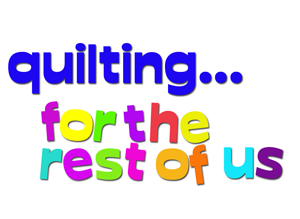I got talked into this class. Really--they really had to twist my arm. (Stop that laughing. I can hear you.) I love Twitter, but sometimes those #Twilters, they can be real enablers. Still n' all, in this case, it was a tremendously useful enable!
I was reading tweets about Debbie Caffrey's Cut to It: Strategies for Smarter Quilting at a weak moment: I'd just decided I should make a gift for someone that will involve a ton (a TON) of cutting of the same units, over and over. I wasn't looking forward to it, so anything that sounded like it might help me be faster and more accurate at the same time seemed like it would be worth a try.
I loved this class. It's not the kind of class that I can post pictures of projects I made because of it, nor have I really been able to put into use most of the techniques taught in the class...yet. I've not been doing that kind of quilting recently. However, watching her did convince me to finally pony up for something I've thought about for awhile--I used a Joann's coupon to buy a second large cutting mat for my cutting table. I keep one mat upside down so it's just a plain surface to make it easier to see ruler lines without the competing lines from the cutting mat beneath, just like she suggests in the class. And it really is nice to have both surfaces available to me. I can still flip either over as I need, but it's nice to have one of each to go back and forth.
I used a double-sided poster-hanging tape to hold both cutting mats steady in place. It just made me fall in love with my cutting table all over again.
I have also started holding my ruler differently based on this class. I've always done the, well, let's call it the Spider Grip--that I was taught early on: fingertips splayed on the ruler (palm lifted up) with the pinky on the mat next to the ruler to hold it in place while cutting. It works well enough, but my hand gets tired after awhile. Debbie has a slightly different hold that works as well in terms of steadiness--if not better--and is more comfortable for long sessions of cutting.
Some of the techniques she's teaching made me almost want to do the "Doh!" forehead slap: Why didn't I think of that before? Such a simple, seemingly small change to how I approach my cutting, but how much more quick and potentially much more accurate it could be. Her charts and graphs in the downloadable materials, which she goes over in good detail in the lessons, may seem confusing at first but once you get the concept, they will make things go much more quickly in the future.
I particularly liked the lessons on jelly rolls and fat quarters because I have a lot of them and she offers a lot of helpful tips for dealing with issues they can sometimes bring with them. I tweeted after watching some of those lessons that I wanted to run right into my sewing studio and start slicing away! I may not be much of a traditional quilter these days, but I loved the blocks from Lesson 4, especially when she laid three of them out side-by-side. I immediately thought, "Boy, I wouldn't mind using that for a holiday table runner."
There aren't really projects related to the tips she teaches per se, but she does include a quilt pattern that does use the tips if you want to do it. However, it's not emphasized in the lessons--she references it here and there, but there's not really a step-by-step instructional piece just on that project. This is truly a technique class.
She also shows both right-handed and left-handed positions for different techniques,how to use rulers in lieu of templates (something I'm going to start trying on my Jinny Beyer Block of the Month which is Template Central), working on the bias, trapezoids, and so forth. Lesson 6 is a really interesting look at how to figure out how many pieces you can slice one unit into for very different results. Fun stuff!
So, in other words, this was an incredibly useful class. It's one that, even though I watched it all the way through, I'm sure I'm going to keep going back and watching individual lessons or parts of lessons to refresh my memory before I start certain types of projects. Including that gift I mentioned. Yikes.
The Basics
- 7 lessons, ranging from 20 minutes to 34 minutes, mostly in the 30 minute range. (She doesn't mess around!)
- Lesson 1 gets through the basic introduction stuff pretty quickly; she then dives right into some foundational guidelines for holding different types of rulers and the most efficient way to approach some standard cutting tasks--strips, cross-cutting, diamonds, chevrons, and so forth.
- Lesson 2 is all about strips; lesson 3 is half-square triangles (HSTs), quarter-square triangles, and trapezoids; lesson 4 is fat quarters and templates; lesson 5 is squares into Delectable Mountain blocks of various types; lesson 6 also addresses squaring up, and slicing simple blocks up to form more complex units; and lesson 7 is doing bias HSTs.
- Class materials include a 15-page reference for everything she talks about in class, plus another PDF with the quilt pattern. Even if you don't want to make the quilt, it's worth downloading this PDF as she does address the pattern specifically at one point to demonstrate how to calculate for cutting and you may want to be looking at it for reference as she does.
Debbie Caffrey's Cut to It: Strategies for Smarter Quilting was a great purchase. This is definitely reference material for some time to come. She has a second class available that I'm now eyeing: Clever Cuts for Efficient Quilting. I'll probably be picking that one up once I knock out another class or two that I already own.
(Using Craftsy links in this post helps support my podcast and blog. Thanks so much!)


